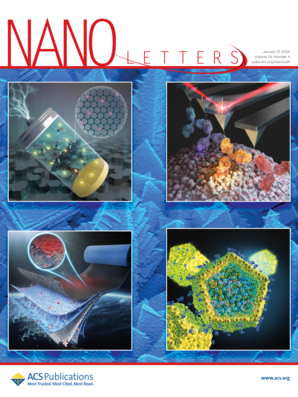Unraveling Charge Transport in Heterostructured Nanomotors for Efficient Photocatalytic Motion.
IF 9.6
1区 材料科学
Q1 CHEMISTRY, MULTIDISCIPLINARY
引用次数: 0
Abstract
Photocatalytic micro/nanomotors have emerged as promising tools for environmental remediation, biosensing, and targeted delivery. To enhance their light-driven propulsion, significant efforts have focused on engineering semiconductor heterostructures, which promote charge separation. However, a clear understanding of how these architectures govern photocatalytic mechanisms and influence motion performance remains limited. Here, we design a visible light-responsive nanomotor based on a Fe2O3-Pt-TiO2 trilayered heterostructure, combining narrow-bandgap α-Fe2O3 and wide-bandgap TiO2 with an intermediate Pt layer. Remarkably, Fe2O3-TiO2 nanomotors without the Pt layer exhibit only modest propulsion under visible light, whereas the inclusion of Pt significantly enhances their motility. Through advanced techniques, including in situ synchrotron radiation-based near-ambient pressure X-ray photoelectron spectroscopy and transient absorption spectroscopy, we reveal that Pt serves as an efficient electron mediator, enabling directional charge transfer across the heterojunction. This study provides fundamental insights into charge transport in multicomponent nanomotors and introduces a rational strategy for designing efficient photoactive systems.异质结构纳米马达中有效光催化运动的电荷输运。
光催化微/纳米马达已成为环境修复、生物传感和靶向递送的有前途的工具。为了增强它们的光驱动推进,大量的工作集中在工程半导体异质结构上,这促进了电荷分离。然而,对这些结构如何控制光催化机制和影响运动性能的清楚理解仍然有限。本文设计了一种基于Fe2O3-Pt-TiO2三层异质结构的可见光响应纳米电机,该结构将窄带隙α-Fe2O3和宽带隙TiO2结合在一起,中间有一个Pt层。值得注意的是,没有Pt层的Fe2O3-TiO2纳米电机在可见光下仅表现出适度的推进力,而Pt层的加入显著增强了其运动能力。通过先进的技术,包括基于原位同步辐射的近环境压力x射线光电子能谱和瞬态吸收能谱,我们揭示了Pt作为一种有效的电子介质,能够在异质结上实现定向电荷转移。本研究为多组分纳米电机中的电荷输运提供了基本的见解,并为设计高效的光活性系统提供了合理的策略。
本文章由计算机程序翻译,如有差异,请以英文原文为准。
求助全文
约1分钟内获得全文
求助全文
来源期刊

Nano Letters
工程技术-材料科学:综合
CiteScore
16.80
自引率
2.80%
发文量
1182
审稿时长
1.4 months
期刊介绍:
Nano Letters serves as a dynamic platform for promptly disseminating original results in fundamental, applied, and emerging research across all facets of nanoscience and nanotechnology. A pivotal criterion for inclusion within Nano Letters is the convergence of at least two different areas or disciplines, ensuring a rich interdisciplinary scope. The journal is dedicated to fostering exploration in diverse areas, including:
- Experimental and theoretical findings on physical, chemical, and biological phenomena at the nanoscale
- Synthesis, characterization, and processing of organic, inorganic, polymer, and hybrid nanomaterials through physical, chemical, and biological methodologies
- Modeling and simulation of synthetic, assembly, and interaction processes
- Realization of integrated nanostructures and nano-engineered devices exhibiting advanced performance
- Applications of nanoscale materials in living and environmental systems
Nano Letters is committed to advancing and showcasing groundbreaking research that intersects various domains, fostering innovation and collaboration in the ever-evolving field of nanoscience and nanotechnology.
 求助内容:
求助内容: 应助结果提醒方式:
应助结果提醒方式:


